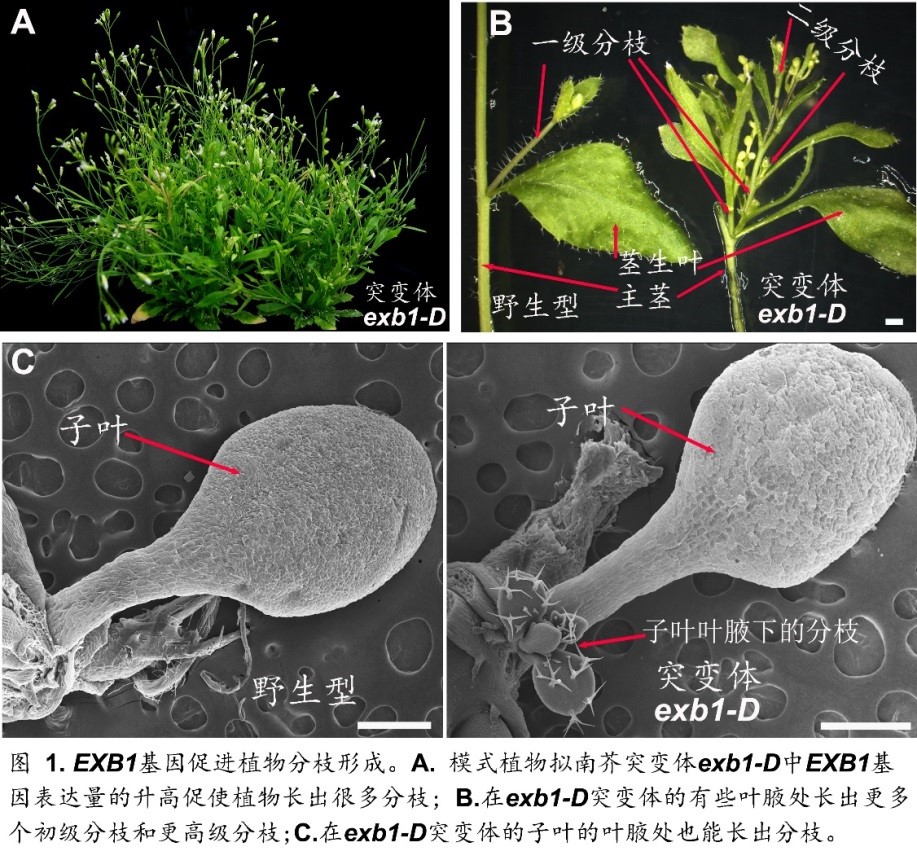Plant Cell:北京大学生科院秦跟基课题组发现调控植物分枝形成重
11月17日,国际知名学术期刊《plant Cell》上发表北京大学生命科学学院秦跟基教授课题组的一篇研究论文,题为“The WRKY Transcription Factor WRKY71/EXB1 Controls Shoot Branching by Transcriptionally Regulating RAX Genes in Arabidopsis”。研究不仅发现了一个重要的调控植物分枝的基因,完善了植物分枝调控网络,还为通过分子设计育种提高农作物产量提供了基因资源。论文的第一作者是北京大学生命科学学院博士研究生郭冬姝,生命科学学院及现代农学院的秦跟基教授为论文通讯作者。
爱种花草的人都知道,有的花草种得好会形成很多分枝,而疏于管理可能就不会长得那么茂盛了。其实植物分枝的多少不仅是植物在形态上适应环境的一种非常重要的方式,而且可以影响粮食作物的产量。那么植物的分枝是如何形成的呢?分枝形成的过程又是如何调控的呢?这一直是很多科学家非常感兴趣的科学问题。目前已经知道植物分枝形成至少需要两个重要步骤,第一步是在叶的基部叶腋处长出形成分枝的干细胞(即腋芽分生组织);第二步是干细胞形成休眠芽或形成分枝,第二步与所谓的“顶端优势”有关,受植物激素生长素的严格控制。以前的研究已经发现了一些名为“腋芽分生组织调控因子”(REGULATOR OF AXILLARY MERISTEMS,RAX)的MYB类转录因子对干细胞形成起非常重要的作用。这些转录因子蛋白的功能非常保守,在拟南芥、番茄、辣椒等植物中都调控腋芽干细胞的形成。但这些重要RAX基因又是如何被调控的呢?
北京大学生命科学学院秦跟基教授课题组通过正向遗传学方法鉴定了一个促进植物分枝增多的基因,命名为“过多分枝”(EXCESSIVE BRANCHES 1,EXB1)。在突变体exb1-D中EXB1基因的表达量的升高,植物就长出很多分枝(图1A),而且有些叶腋处长出更多个初级分枝和更高级分枝(图1B),甚至在子叶的叶腋处也能长出分枝(图1C)。这说明EXB1基因可促进腋芽干细胞的形成,甚至可以在正常情况下不能形成腋芽干细胞的部位也能形成腋芽干细胞。他们通过研究发现,EXB1基因编码一个植物中特有的WRKY类转录因子。EXB1通过调控RAX基因的表达来促进分枝,而且体内和体外实验证明EXB1是直接结合到RAX基因的启动子区,从而调控RAX基因的表达。同时,植物激素生长素也在EXB1促进植物分枝形成的过程中起重要作用。

原文链接:
The WRKY Transcription Factor WRKY71/EXB1 Controls Shoot Branching by Transcriptionally Regulating RAX GENEs in Arabidopsis
原文摘要:
Plant shoot branching is pivotal for developmental plasticity and crop yield. The formation of branch meristems is regulated by several key transcription factors including REGULATOR OF AXILLARY MERISTEMS1 (RAX1), RAX2, and RAX3. However, the regulatory network of shoot branching is still largely unknown. Here, we report the identification of EXCESSIVE BRANCHES1 (EXB1), which affects axillary meristem (AM) initiation and bud activity. Overexpression of EXB1 in the gain-of-function mutant exb1-D leads to severe bushy and dwarf phenotypes, which result from excessive AM initiation and elevated bud activities. EXB1 encodes the WRKY transcription factor WRKY71, which has demonstrated transactivation activities. Disruption of WRKY71/EXB1 by chimeric repressor silencing technology leads to fewer branches, indicating that EXB1 plays important roles in the control of shoot branching. We demonstrate that EXB1 controls AM initiation by positively regulating the transcription of RAX1, RAX2, and RAX3. Disruption of the RAX genes partially rescues the branching phenotype caused by EXB1 overexpression. We further show that EXB1 also regulates auxin homeostasis in control of shoot branching. Our data demonstrate that EXB1 plays pivotal roles in shoot branching by regulating both transcription of RAX genes and auxin pathways.
作者:秦跟基

